Optimizing Building Management with a Lifecycle Approach
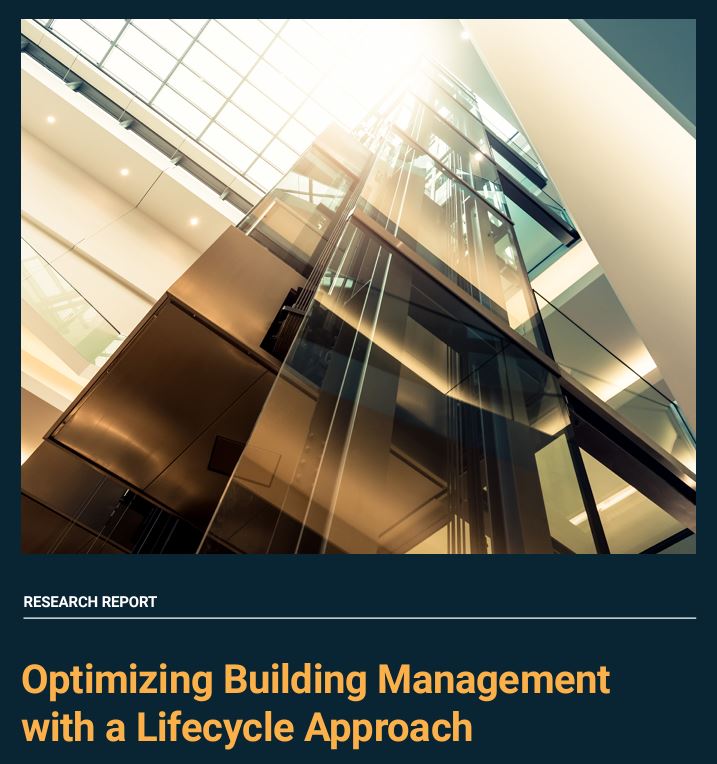
With the building industry facing new efficiency and sustainability challenges, this report explores the crucial role facility managers can play in fostering better collaboration across the architecture, engineering, construction and operations (AECO) lifecycle.

RESEARCH REPORT
Optimizing Building Management with a Lifecycle Approach
Welcome
Achieving sustainable and resource-efficient buildings will require a more coordinated approach across design, construction, and operations, along with improved data sharing.
With the building industry facing new efficiency and sustainability challenges, this report explores the crucial role facility managers can play in fostering better collaboration across the architecture, engineering, construction, and operations (AECO) lifecycle.
Industry fragmentation across the AECO lifecycle has long hindered efficiency. More collaboration and data sharing are crucial steps toward extending the lifespan of buildings and reducing waste.
One significant obstacle to change is the siloed nature of data and teams throughout the building lifecycle. Even though multiple stakeholders produce huge amounts of data, it is often created in silos and using different data formats. 95% of data generated through the construction process is lost and not shared downstream in operations1. This creates inefficiencies and impedes valuable collaboration.
The good news is that advances in technology and the evolution of data standards are already helping to bridge the data gap from architecture, engineering and construction (AEC) to operations.
Software providers are drawing on the advances of the cloud to improve information exchanges across design, construction, and operations. One of the most exciting new technologies having an impact today is digital twins, with immense potential to serve as a digital thread throughout the AECO lifecycle.
This report analyzes these trends and presents practical recommendations to empower facility managers to play a key role in bridging gaps throughout the building lifecycle.
95% of data generated during construction goes unused.
“There needs to be more collaboration between AEC and FM relative to Building Lifecycle Management. AEC owns a project for 18-36 months, but Operations deals with it for the next 75-100 years. ‘Value Engineering’ in projects will frequently impact the effectiveness of future operations.
Technology is no longer a constraint, but the CRE industry must adopt a lifecycle management mindset that spans its policies, standards, and procedures.”
DEAN STANBERRY
Chairman, IFMA Global Board of Directors
Contents
| 07 | Building Lifecycle Definition |
| 08 | Headline Findings |
| 10 | Priorities in Facility Management |
| 14 | AECO Data Gap |
| 20 | Recommendations |
| 23 | Conclusion |
Research Methodology
The polling segment of the project was open for 90 days, from August to October 2023, with 212 completed responses. We sent the survey to the IFMA IT Community and the Autodesk Research Community.
Survey respondents predominantly were in the facility management sector, also with representation from AEC, real estate, and technology provider professions.
They represented a broad range of industries, with the largest segments coming from technology, education, healthcare, governance, and commercial real estate.
Top Regions & Sectors Surveyed
| TECHNOLOGY | |
| MUSH* | |
| REAL ESTATE | |
| FINANCIAL SERVICES |
Acronyms
The report uses the following acronyms:
| AEC: | Architecture, Engineering and Construction |
| AECO: | Architecture, Engineering, Construction and Operations |
| AI: | Artificial Intelligence |
| BIM: | Building Information Modeling |
| BMS: | Building Management System |
| CMMS: | Computerized Maintenance Management System |
| CRE: | Corporate Real Estate |
| FM: | Facility Management |
| IWMS: | Integrated Workplace Management System |
| MUSH: | Municipalities, Universities, Schools and Hospitals |
DEFINITION
BUILDING LIFECYCLE
Encompasses the phases of planning, design, construction, operations, and renovation or demolition.
The operations phase is the longest, accounting for 60-80% of total lifecycle costs. It involves activities such as maintenance, space optimization, workplace experience and tenant management.
Considering the full building lifecycle at each phase gives stakeholders a more comprehensive understanding of costs, risks, and opportunities. It drives architects and engineers to make design choices that can reduce environmental impact and operational costs. In operations, considering total lifecycle costs drives asset and maintenance decisions that reduce long-term spending and extend asset lifespans.

60-80% of lifecycle costs occur in operations
HEADLINE FINDINGS
Adopting a building lifecycle mindset is highly valuable for facility managers. It enables them to maximize the lifespan of building systems, plan for the long term, support sustainability goals, and make strategic decisions.
Facility managers continue to encounter challenges accessing data generated from the AEC process. The challenges includes incomplete contractor documentation following handover and a lack of data standardization across AECO stakeholders. The industry is on the cusp of change with the increasing inclusion of facility managers in design-build processes and the evolution of digital twins to serve as a bi-directional digital thread throughout the lifecycle.
Facility managers are in a prime position to lead change in bringing more connection to the lifecycle. Proactive coordination, defining BIM requirements, and establishing digital handover processes can enhance data sharing.
96%
Facility managers believes AEC data enhances key processes
12%
Average time wasted because of fragmented data
70%
Expect greater collaboration with workplace designers
20%
Plan to invest in digital twins in the next 12 months
REPORT FINDINGS
Facility Managers Demonstrate Influence Beyond Operations
It is well known that facility managers play a key role in ensuring the efficient and safe operation of buildings and infrastructure, helping their organizations push for ever-greater cost efficiency and space optimization. At the same time, facility managers are starting to find themselves as key stakeholders influencing broader projects such as workplace redesigns, capital upgrades, and renovations, helping to extend the lifespan of buildings.
Over the next three years, respondents expect greater visibility from the C-suite and greater collaboration with other business stakeholders. A notable 70% predicts more collaboration with workplace designers, reflecting facility managers’ growing influence on workplace redesign and facility upgrades.
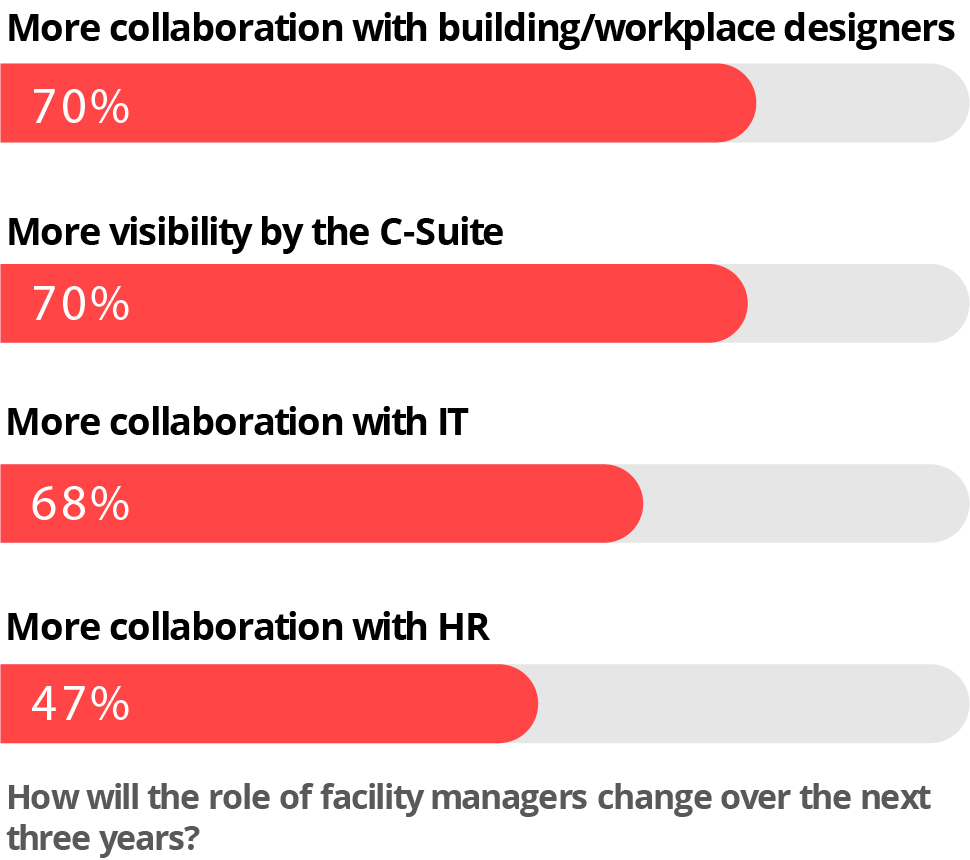

70% of facility managers predict more collaboration with designers.
Immediate Priorities: Driving More Efficient Buildings
The immediate agenda of facility managers is shaped by:
- Push for ever-greater efficiency. With continuing economic headwinds, organizations are focused on streamlining their operations and cutting expenses across the business. Fifty percent of survey respondents told us they are under pressure to reduce costs, driving strategies to improve contractor performance and reduce energy costs.
- Space optimization pressures. Companies continue to prioritize space efficiency to ensure all space drives strategic value rather than sit idle. This involves not only tracking how space is used but also optimizing layouts, reallocating the use of space, and sometimes rationalizing portfolios.
- Demand for renovation projects. As buildings and infrastructure age, they need updates and renovations to meet current standards, codes, and regulations. In Europe, the Renovation Wave Strategy, part of the European Green Deal, aims to double the renovation rate of buildings in the EU by 2030. The survey highlights that this is shaping the role of facility managers, with 38% rating building upgrades and renovations as a top priority.
Top five facility management challenges in the next 12 months
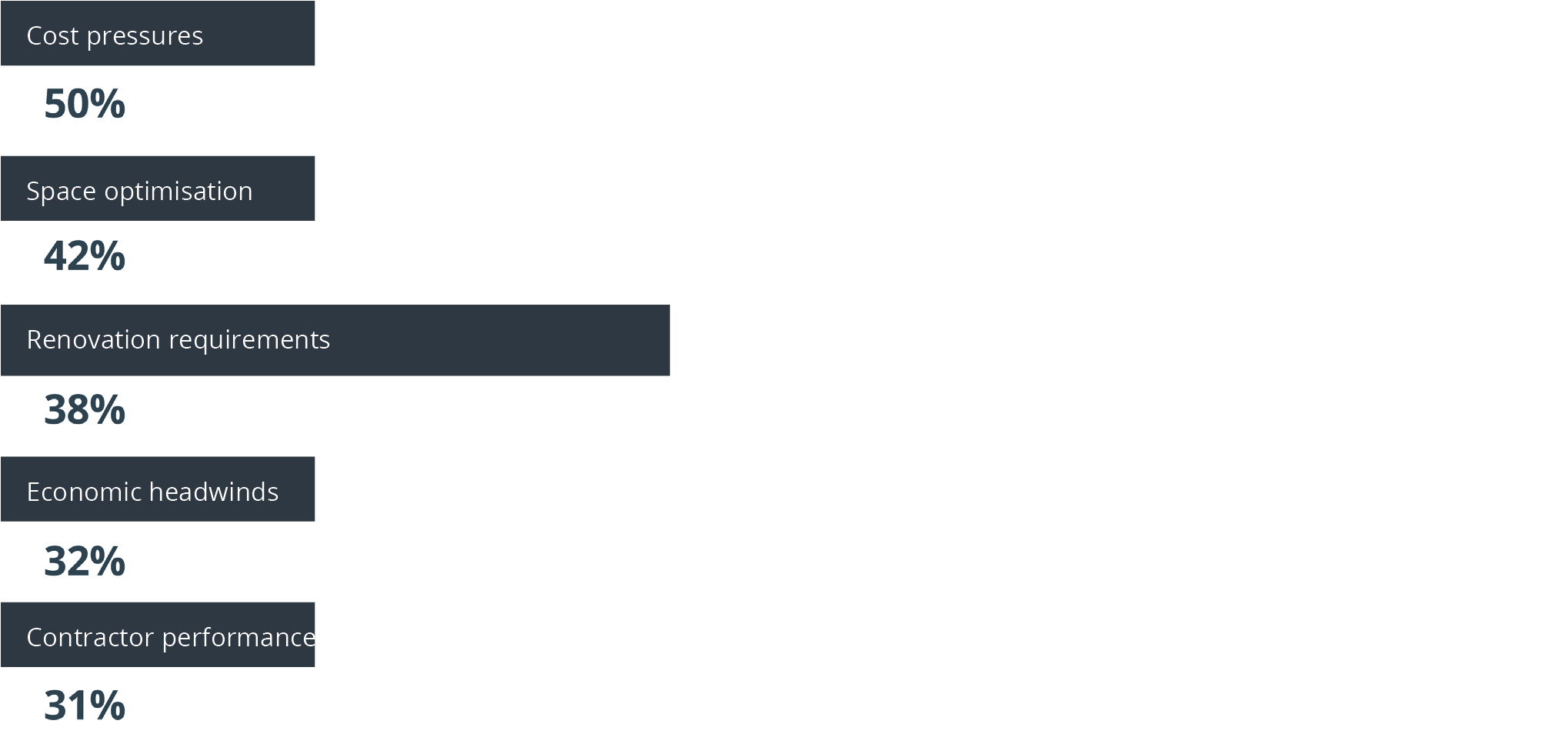
Facility Managers are Planning for a Data-Driven Future
In the coming years, facility managers also plan to enter a more digital future. This presents new opportunities but may also strain technology skills and experience relative to data analytics and governance. The findings of the survey indicate several key trends:
- 87% will use more data and analytics to shape decision-making. Facility managers are preparing to leverage data and analytics to enhance their operational processes. By utilizing a wider range of data sets, including current condition data, asset lifecycle data, and budget data, facility managers can make more informed decisions to optimize their facilities’ performance.
- 78% expect to use AI in daily tasks and data analysis. AI technologies have the potential to streamline and automate some processes like fault detection or maintenance scheduling, enabling more efficient operations and resource allocation. Additionally, AI can play a role in data analysis, extracting valuable insights that contribute to improved decision-making.
- 70% anticipate more collaboration with IT departments. As the facility management profession transitions toward a more software-driven future, collaboration with the IT department will become crucial. The IT department is vital in implementing and integrating software systems, data platforms, and analytics tools that support data-driven facility management.
INSIGHT
The drastic rise of data and analytics usage indicate a looming technology skills gap; the facility management sector will need more professionals with technology skills relative to data governance and analytics.
Facility Managers Plan to Leverage Real-Time Data to Enhance Decision Making
Over two-thirds of respondents anticipate investing in granular data insights by deploying new software systems and data capture devices.
- Managers plan to augment existing data management systems, which often rely on manual inputs, with more granular, near-real-time data to drive more proactive and timely maintenance. They believe space management, maintenance management and energy optimization are the most likely workflows that will be enhanced with more granular data.
- The top technology categories for investment in the next 12 months include energy monitoring systems (51% respondents investing), BMS analytics (44%), sensors (43%) and near real-time digital twins for centralized insights (20%).
67%
Facility managers plan to invest in near real-time data solutions in the next 12 months
Efficiency opportunities from using near real-time data
- 20% more efficient
- 10% more efficient
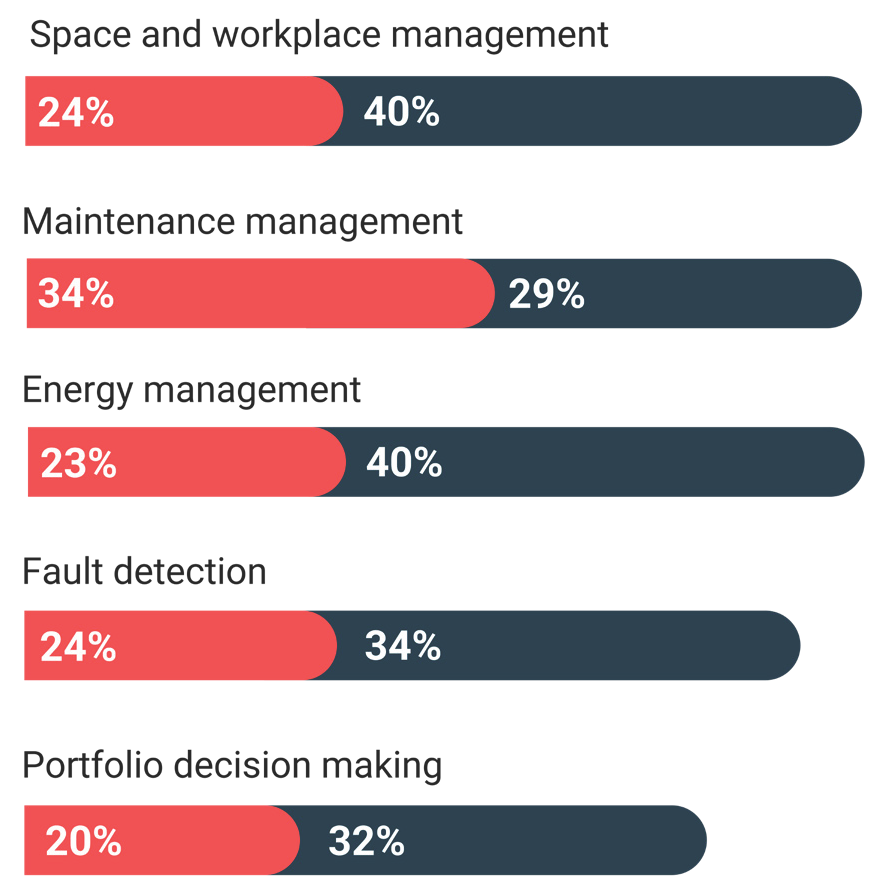
What value do you believe real-time data can bring to the following facility management workflows?
Firms Require Broad Data Sets for Successful Facility Management
Reflecting their broad responsibilities, facility managers require access to a broad range of data sets to be successful. A significant amount of the asset and spatial information required to efficiently operate the facility is created during design and construction.
- Current condition data. Facility managers rate asset and facility condition as the most important data set for success. Having access to up-to-date data allows facility managers to monitor the performance of critical systems and take prompt action when issues arise.
- Asset lifecycle data. Understanding an asset’s full lifecycle history is crucial for effective facility management. This can help firms schedule preventive maintenance at optimal intervals to maximize lifespan. This prevents premature failures or breakdowns.
- Financial insights and budgets. With a sharp focus on cost efficiency, facility managers are looking to track expenses, identify cost-saving opportunities, and optimize the allocation of financial resources.
- Sustainability insights. Although it is not currently a main focus, facility managers are increasingly curious about their sustainability footprint from embodied to operational carbon.
Asset lifecycle data is crucial for successful facility management

Facility Managers are Keen to Bridge the Data Gap from AEC to Operations
As facility managers plan for a more data-driven future, they are also interested in closing the data gap from AEC to operations. A notable 96% of the respondents believe the data generated through the AEC process can bring significant value to facility operations. AEC data includes architectural drawings, as-built drawings, engineering models, specifications, and construction documents.
96% of facility managers believe the data generated through AEC processes can bring significant value to operations.
Top four benefits of using data from the AEC process in facility management:
| 01 | Enhancing asset management. AEC data can provide valuable insights that improve asset management by providing visibility in building layouts, building materials, and equipment defects at commissioning. Facility managers can utilize this data to populate a CMMS, IWMS, or an operational digital twin to develop effective asset management strategies to prioritize maintenance tasks and plan for future asset replacement cycles. |
| 02 | Improving building handover. Building handover marks the transition from the construction phase to the operational phase. By accessing CAD, BIM, and construction documentation, facility managers can ensure a smooth transition and gain a comprehensive understanding of the building’s design intent and functionality. Access to this knowledge facilitates effective operations, maintenance planning, and troubleshooting of potential issues. |
| 03 | Optimizing space planning and decisions. Space management decisions require various inputs, including utilization data, lease data, and floor plans. 2D floor plans, often created by architects and workplace designers, provide essential visualization of spaces to inform decisions about space allocation and optimization. |
| 04 | Enabling smarter renovations. As buildings across North America and Europe age, they must be renovated and reimagined over the coming decades. Having access to as-built models with details of existing materials and structures enhances efficiency. |
DEFINITION
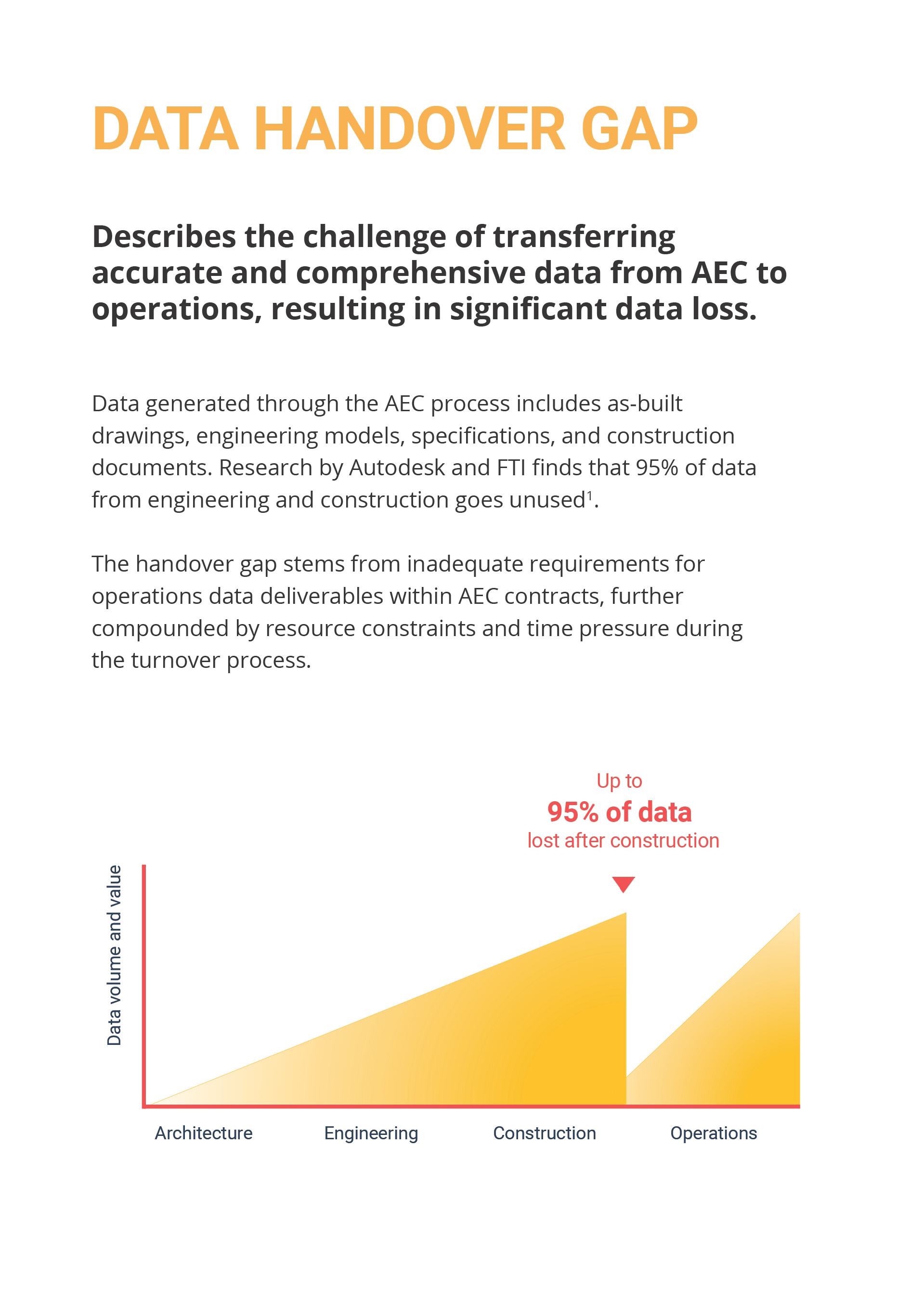
Facility management processes enhanced with design and construction data
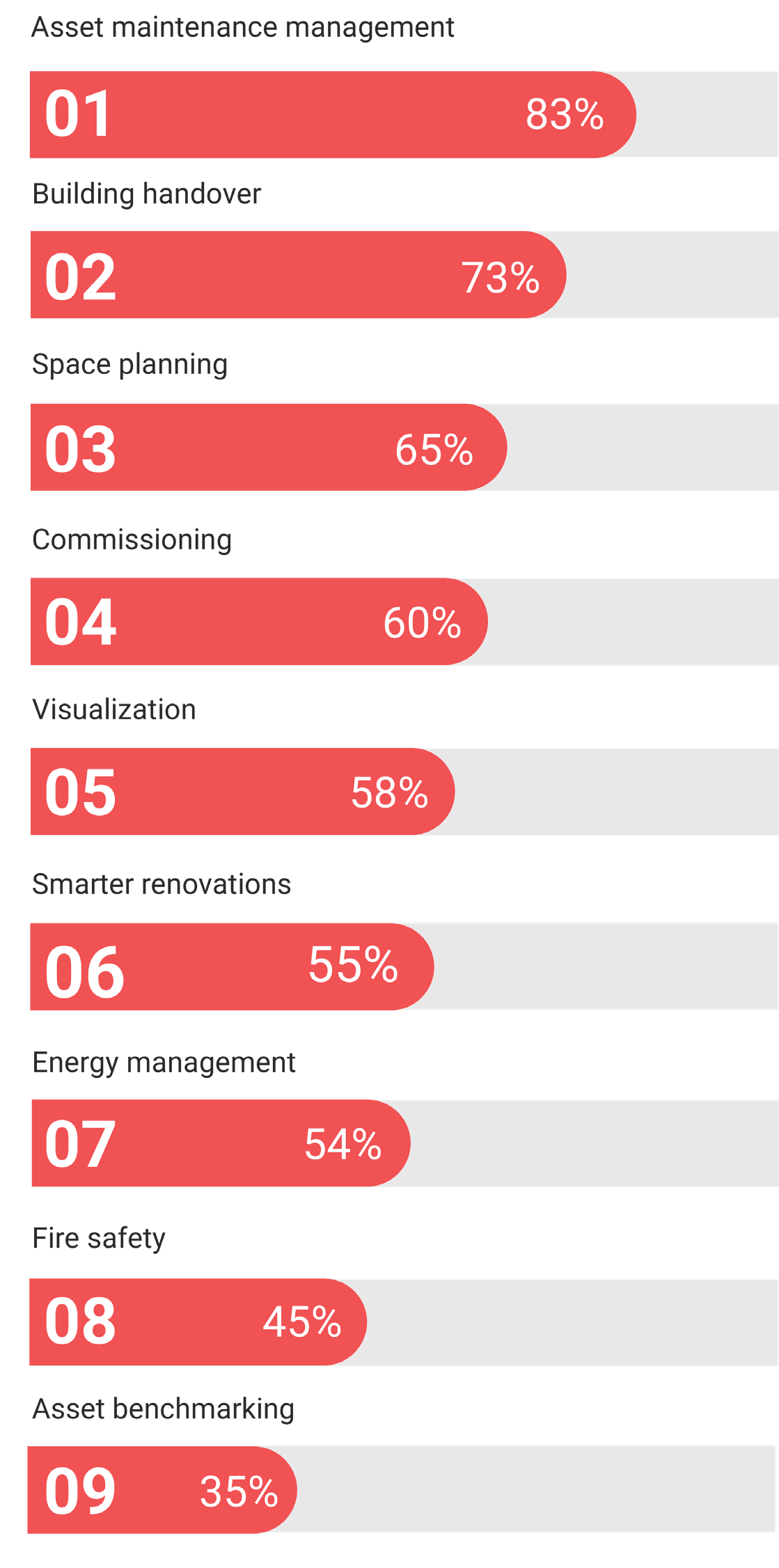
What facility management processes do you believe can be enhanced by access to data generated through the design and construction process? (includes CAD/BIM/asset data)
BIM Usage is on the Rise in Facility Management
The survey also highlights:
- BIM for facility operations is on the rise. BIM has now expanded well beyond its initial application in architecture. According to our survey, 32% of firms already use BIM to support facility operations at one or more facilities. There was higher BIM usage among education, healthcare, and government sectors (45%) but lower uptake by the financial services sector (only 7%).
- Firms tend to use BIM with a CMMS-IWMS for operations. Most building operators will use BIM combined with a CMMS to empower maintenance processes. This is clear from the survey, as 80% of the firms using BIM for operations also use a CMMS system.
- BIM is becoming a common part of projects. The survey highlights that firms are increasingly using BIM on new projects; 33% of respondents state their firm intends to use BIM on all or most of their projects. This trend indicates an opportunity for facility managers to influence data management processes and to ask their contractors for access to BIM deliverables.
“We recently began integrating BIM and facility management through collaboration by our design and facility management teams. We are ensuring handover plans for new projects include details for preparing BIMs for streamlined integration to our operations systems. These are exciting times for facility management, and I look forward to utilizing BIM for the entire facility lifecycle as we develop Digital Twins of our physical facilities.”
ED NOVAK
Senior Project Manager, Facilities & IT Infrastructure, Delta Dental
- Facility managers still see BIM as complex. Even though BIM uptake is growing in operations, facility managers remain concerned with the cost and complexity of utilizing BIM in operations as well as the connectivity to other systems in use within their organizations. The good news is that cloud-based digital twin platforms are helping democratize BIM for broader operations stakeholders.
Opportunity Remains for Better Data Sharing
Even though the usage of AEC data through operations is growing, there remains room for better data sharing across the building lifecycle. The research reinforced some of the key industry challenges:
- Suboptimal representation of facility managers during design and build processes. While the survey showed a positive trend and growing influence, 80% of respondents said facility managers are not consistently involved in the design and build process. This absence during critical stages prevents facility teams from shaping AEC data collection processes to ensure the acquisition of useful asset data. Greater collaboration between facility managers and design-build teams can optimize data collection and enhance post-project asset data.
- Inconsistent asset naming conventions across AECO. According to our survey, 46% of firms either lack a standardized approach or have developed their own asset naming conventions. The lack of a standardized approach to naming assets is a key factor hindering efficient data sharing and collaboration. For example, facility managers can sometimes find data in BIM following handover isn’t in a suitable format for their operational needs. Establishing a common language to describe assets is crucial for seamless integration and improved data management.
- Handover documentation can be disjointed. Handover packages often include disparate outputs such as paper files, PDFs, BIM models, spreadsheets, and COBIE data. This fragmentation hampers data integration and management downstream, often leading to the recreation of asset data after building handover. Respondents also highlighted handover data can be sub-optimal, as cost and schedule pressures at the end of projects compromise the quality.
- Poor connections from AEC to operations software. Respondents believed there is insufficient interoperability between AEC software and CMMS-IWMS systems, disrupting the smooth flow of data through the building lifecycle. One of the underlying problems is the wide range of data models used by organizations, driving the need for unique Extract, Transform, Load processes to move data across software solutions.

Do not consistently involve FM in construction processes
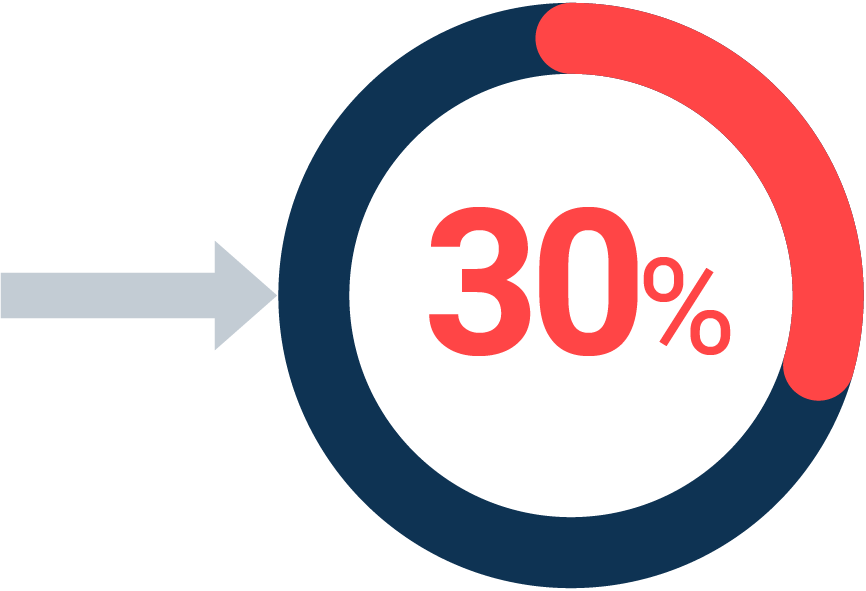
BIM data is not in a suitable format for operations
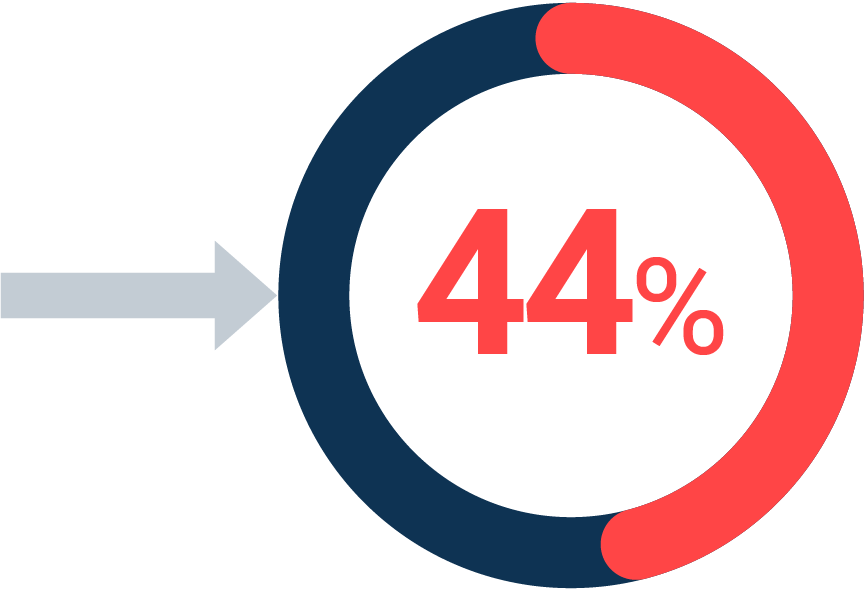
Weak connections from BIM to IWMS
Data Fragmentation Continues into Operations
- Spreadsheets and emails are still some of the most common ways that firms manage their facility management, along with more evolved approaches, including a CMMS-IWMS. The fragmentation of data is leading to inefficiency. More than 60% of respondents estimate that 10–20% of wasted resource time is the result of poor-quality data and systems integration.
- Large multi-site firms that use lots of disparate software solutions to manage their real estate facility data run into lots of problems. The proper usage of an CMMS-IWMS along with strong data governance approaches can help firms improve their data quality and enhance strategic decision making.
- INSIGHT: The high reliance on spreadsheets and email is contributing to poor data governance in the sector. These approaches are error-prone and not robust enough to support major operational functions.
Solutions used to manage facility management data

What solutions are you using to manage your facility, maintenance and workplace data?
5 Next Steps
The Future of Building Lifecycle Management
Sharing building data across the AECO lifecycle can bring value to all parties involved. For facility managers, it provides access to rich asset and spatial data, while for building designers, it helps them understand how buildings are operated to help inform future planning. Facility managers are well-positioned to play a pivotal role in driving this transformative change. The closing section of this report proposes key steps facility managers can take to help drive enhanced data sharing with the broader ecosystem.
01
Take a leadership role in driving change and connecting the lifecycle.
Our survey indicates facility managers are in a prime position to be change drivers. The survey respondents expect the profession will benefit from the increased visibility of the C-suite and greater collaboration with other departments in the coming years. Facility managers have the opportunity to champion a more connected approach within the AECO industry. Building relationships across different internal functions, design contractors and external technology consultants will be crucial in supporting this change.
02
Push for an early role in the AEC data management process.
Closing the data gap between AEC and operations requires facility managers to become more involved in design and build management processes from the early stages. Facility managers should be a project stakeholder at the kickoff meeting and then ensure their requirements are reflected in AEC contracts and project management milestones. Even if the facility manager is not yet hired, there should be an operations stakeholder on the project similar to the engineering consultant. Here are some key questions to ask at the start of a project: What data should be tracked? What naming conventions should be used? What is the naming nomenclature for the data? What operational systems do we plan to use in the future?
03
Use industry standards within your data governance strategy.
Given the involvement of multiple firms in the building lifecycle, industry standards and guidelines can play a role in helping to establish a common language. While there is no single standout industry approach, our survey highlights the growing uptake of OSCRE which aims to establish an enterprise data strategy for real estate and build data integration capabilities across the supply chain. Additionally, the ISO 19650 provides guidelines for managing data over the entire life cycle of a built asset using BIM is garnering traction. Facility managers should spend time understanding the pros and cons of these different approaches as part of a more integrated data governance approach.
Leverage cloud advances for better data flow.
While survey respondents noted compatibility challenges between BIM and CMMS, technology advancements are helping to bridge the data gap from AEC to operations. Software providers are leveraging the cloud to improve information exchanges across design, construction, and operation disciplines. With an evolving technology landscape, it is worthwhile to work with your technology service providers to understand your changing options.
04
05
Embrace the new wave of digital innovation from digital twins.
Facility managers are gearing up to embrace a new wave of digital innovation by planning to leverage real-time data, analytics, and AI in their operations. One key area of investment focus is digital twins, with 20% of firms planning to invest in them within the next 12 months. Digital twins hold immense potential to serve as digital threads throughout the asset lifecycle, facilitating greater connectivity across the AECO process.
"Facility managers can be the catalyst for positive change in their organizations by embracing digitization and partnering with their fellow department heads and partners."
TED RITTER
Global Co-Chair,
IT Community of IFMA
Conclusion
Towards A More Connected & Data-Driven Future
- Facility managers are preparing for a more data-driven future, enabling facility strategies to be driven by operational insights rather than intuition or outdated insights.
- Bridging the data gap from AEC to operations is a key part of this data-driven future, with nearly 96% of facility managers recognizing the significant value data from design and construction processes can bring to operational processes.
- However, there remains underlying challenges with data governance and management processes. This is highlighted by the fact operational data is frequently managed outside of robust offerings like a CMMS or operational digital twins with a high reliance on spreadsheets and emails.
- Data interoperability between AEC and operational systems is hindered by a lack of data standards and the limited involvement of facility/operations professionals during the design and construction phases.
- To fully embrace the opportunities of data-driven facility management, firms must prioritize enhancing governance and collaboration efforts. Furthermore, the facility management sector should actively seek out professionals skilled in data analysis and experienced in leveraging data-driven approaches.
- These transformative times present an exciting opportunity for facility managers to lead the charge in embracing change and fostering a more connected data landscape across AECO.
Continue the conversation
Enjoyed this research report? Continue the conversation and participate in future research to stay ahead of the curve!
Autodesk Research Community
Autodesk Research Community
Register with the IFMA IT Community to learn about future research on the industry. Also register with the to provide your unique feedback to our product roadmaps and industry strategy.
About the IT Community of IFMA
The Information Technology Community is dedicated to the continuous improvement of the facility management profession through development, exploration, and analysis of technology tools, solutions, methods, education, and sharing these findings with the profession. We continuously answer the question: “How does Technology Support the Commercial Built Environment, CRE & FM?” We are aligned with the IFMA Vision and Mission Statements and fully support them with a focus on the application of relevant & appropriate technologies.
About Autodesk
The world’s designers, engineers, builders, and creators trust Autodesk to help them design and make anything. From the buildings we live and work in, to the cars we drive and the bridges we drive over. From the products we use and rely on, to the movies and games that inspire us. Autodesk’s Design and Make Platform unlocks the power of data to accelerate insights and automate processes, empowering our customers with the technology to create the world around us and deliver better outcomes for their business and the planet.
About the Autodesk Research Community
Join us in building the Autodesk Research Community (ARC) to drive forward our product roadmap to support your challenges and pioneer new solutions. As a member, you can contribute valuable insights throughout the product development lifecycle - from discovery to launch - evaluating ideas and feedback before and after they are built. We welcome feedback from different professional levels and backgrounds.
Acknowledgements
Thank you to the facility management professionals of the IT Community of IFMA and the Autodesk Research Community for your contributions that made this research possible.


